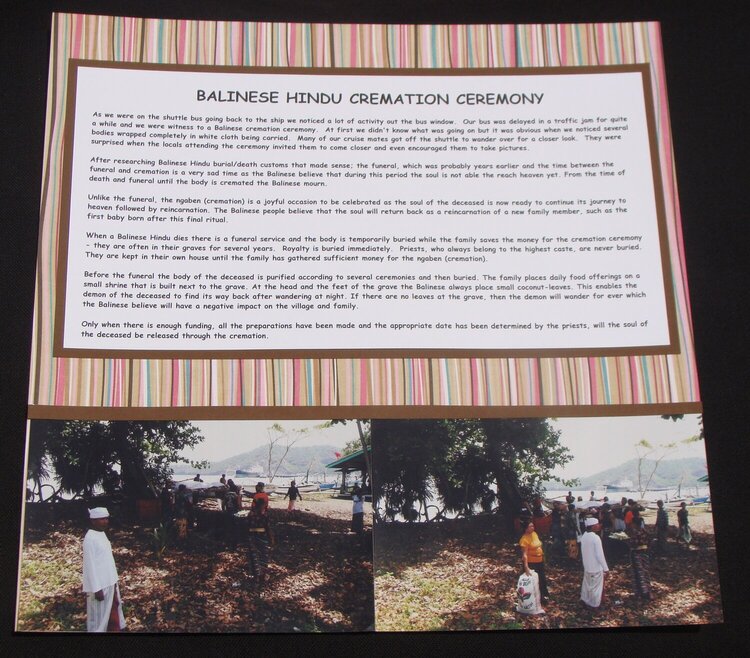

 Give a Cheer
Give a Cheer
BALINESE HINDU CREMATION CEREMONY
As we were on the shuttle bus going back to the ship we noticed a lot of activity out the bus window. Our bus was delayed in a traffic jam for quite a while and we were witness to a Balinese cremation ceremony. At first we didn't know what was going on but it was obvious when we noticed several bodies wrapped completely in white cloth being carried. Many of our cruise mates got off the shuttle to wander over for a closer look. They were surprised when the locals attending the ceremony invited them to come closer and even encouraged them to take pictures.
After researching Balinese Hindu burial/death customs that made sense; the funeral, which was probably years earlier and the time between the funeral and cremation is a very sad time as the Balinese believe that during this period the soul is not able the reach heaven yet. From the time of death and funeral until the body is cremated the Balinese mourn.
Unlike the funeral, the ngaben (cremation) is a joyful occasion to be celebrated as the soul of the deceased is now ready to continue its journey to heaven followed by reincarnation. The Balinese people believe that the soul will return back as a reincarnation of a new family member, such as the first baby born after this final ritual.
When a Balinese Hindu dies there is a funeral service and the body is temporarily buried while the family saves the money for the cremation ceremony - they are often in their graves for several years. Royalty is buried immediately. Priests, who always belong to the highest caste, are never buried. They are kept in their own house until the family has gathered sufficient money for the ngaben (cremation).
Before the funeral the body of the deceased is purified according to several ceremonies and then buried. The family places daily food offerings on a small shrine that is built next to the grave. At the head and the feet of the grave the Balinese always place small coconut-leaves. This enables the demon of the deceased to find its way back after wandering at night. If there are no leaves at the grave, then the demon will wander for ever which the Balinese believe will have a negative impact on the village and family.
Only when there is enough funding, all the preparations have been made and the appropriate date has been determined by the priests, will the soul of the deceased be released through the cremation.
“Strange as it seems, it is in their cremation ceremonies that the Balinese have their greatest fun,” wrote Miguel Covarrubias in his classic work, “Island of Bali,” published in 1937. “A cremation is an occasion for gaiety and not for mourning, since it represents the accomplishment of their most sacred duty, to liberate the souls of the dead."
For the Balinese, a cremation is just one of many rituals that mark the passage from life to the spirit realm. It's elaborate, and expensive. Families will spend all their cash reserves, and more, to give the ancestor a good sendoff and placate the spirit that will take up residence in the family shrine.
A funeral for one person (non-royal) costs a minimum of 45 million rupiah. In American dollars, that is $8,000-$9,000, in a country whose per capita income is under $4,000 a year (most live on much less than that). To put it in perspective, that is what a family may earn in two to three years.
The most common practice is to bury the dead, in the hope that a cremation can be arranged some time in the future. Most commonly, several families and sometimes up to 40 or 50 families will get together when everyone has saved enough money. The more bodies there are in the cremation service, the less it costs each family. With enough being cremated at one time, the price can go down to 6 to 8 million rupiah – still a sizable amount. The bodies, or portions of them, are dug out of the ground for the ceremony. After the cremation, the ashes are poured into the sea.
The three major events which take place before the soul of the deceased is fully released are:
•The Funeral: The bodies are placed into the earth by burial to wait for cremation when the family can afford it.
•The Cremation: the teja (radiance) is released by burning with fire - The body disintegrates into its five earthly elements: earth, wind, water, fire and ether. The soul disappears into the sky.
•The purification of the soul: the ashes are thrown into the water sea.
Every Balinese family has the responsibility to ensure that a proper ngaben takes place if a family member dies. If this does not happen this will have severe consequences for the deceased and his/her family.
In the past the widow would be cremated together with her deceased husband as it was her duty to assist him in finding the right way. Fortunately, when the Dutch ruled over Bali they forbade these practices.
Our photos through the bus windows did not turn out well but other passengers shared these photos with us. I decided not to display any of the graphic photos of the actual cremation.
No products have been added to this project.
Thanks for spreading positivity!
September 03, 2012
August 10, 2012
July 30, 2012
July 25, 2012
July 25, 2012
July 24, 2012
July 24, 2012